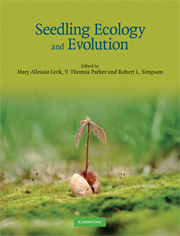Book contents
Chapter 1 - Why seedlings?
Published online by Cambridge University Press: 05 June 2012
Summary
It was, as it were, a little green star with many rays, half an inch in diameter, lifted an inch and a half above the ground on a slender stem. What a feeble beginning for so long-lived a tree! By the next year it will be a star of greater magnitude, and in a few years, if not disturbed, these seedlings will alter the face of Nature here.
Henry D. Thoreau (1993), writing in approximately 1862 about Pinus rigida (Pinaceae).Seedlings as part of a plant's life cycle
The seedling, the young spermatophyte plant following germination, is but one stage in the continuum of a seed plant's life cycle. For ecological purposes, discussion on the life cycle (illustrated in Fig. 1.1) focuses on the processes involved in replacing the adult and/or colonizing new habitats. A reproductive adult plant produces seeds that, once dispersed, become part of the seed bank (Parker et al., 1989; Simpson et al., 1989). Then, following germination, a seedling faces unpredictable environments and is limited by its particular genetic constraints. However, if successful, it survives to adulthood and reproduction.
Seedlings are highly vulnerable, subject to varied abiotic and biotic factors that affect growth and establishment. Their adversities, although variable in severity – depending on habitat and seedling form – include drought, flooding, herbivory, and lack of resources, such as mycorrhizal associates and light.
- Type
- Chapter
- Information
- Seedling Ecology and Evolution , pp. 3 - 14Publisher: Cambridge University PressPrint publication year: 2008
- 14
- Cited by

